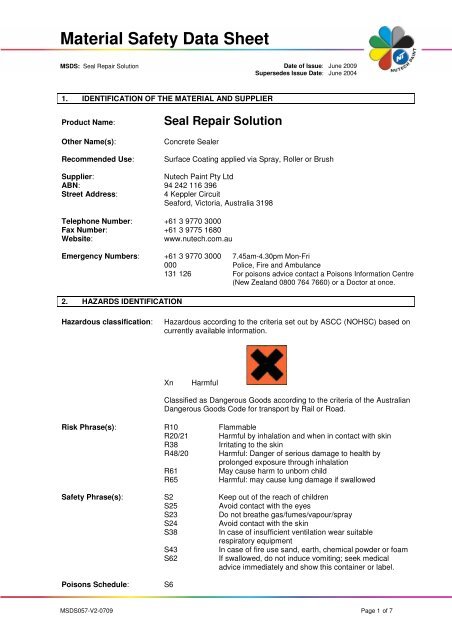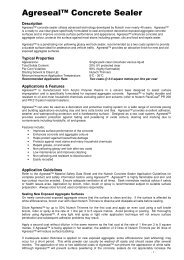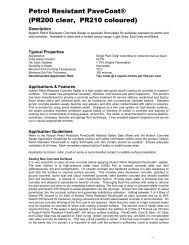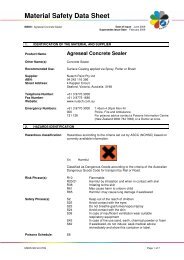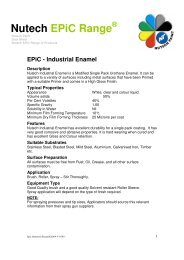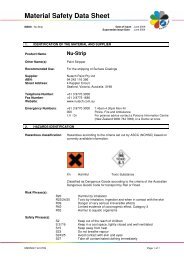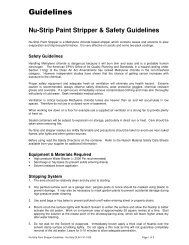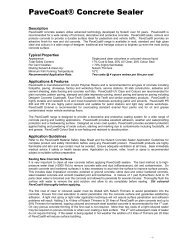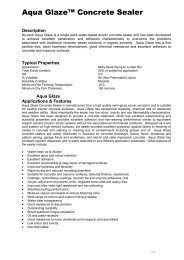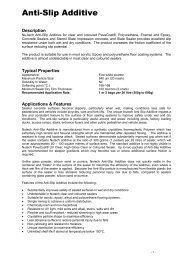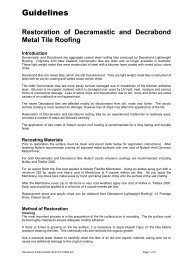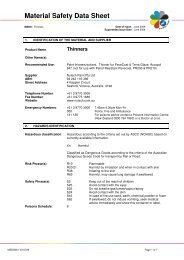Nutech Seal Repair Solution MSDS
Nutech Seal Repair Solution MSDS
Nutech Seal Repair Solution MSDS
Create successful ePaper yourself
Turn your PDF publications into a flip-book with our unique Google optimized e-Paper software.
Material Safety Data Sheet<br />
<strong>MSDS</strong>: <strong>Seal</strong> <strong>Repair</strong> <strong>Solution</strong> Date of Issue: June 2009<br />
Supersedes Issue Date: June 2004<br />
1. IDENTIFICATION OF THE MATERIAL AND SUPPLIER<br />
Product Name: <strong>Seal</strong> <strong>Repair</strong> <strong>Solution</strong><br />
Other Name(s): Concrete <strong>Seal</strong>er<br />
Recommended Use: Surface Coating applied via Spray, Roller or Brush<br />
Supplier: <strong>Nutech</strong> Paint Pty Ltd<br />
ABN: 94 242 116 396<br />
Street Address: 4 Keppler Circuit<br />
Seaford, Victoria, Australia 3198<br />
Telephone Number: +61 3 9770 3000<br />
Fax Number: +61 3 9775 1680<br />
Website: www.nutech.com.au<br />
Emergency Numbers: +61 3 9770 3000 7.45am-4.30pm Mon-Fri<br />
000 Police, Fire and Ambulance<br />
131 126 For poisons advice contact a Poisons Information Centre<br />
(New Zealand 0800 764 7660) or a Doctor at once.<br />
2. HAZARDS IDENTIFICATION<br />
Hazardous classification: Hazardous according to the criteria set out by ASCC (NOHSC) based on<br />
currently available information.<br />
Xn Harmful<br />
Classified as Dangerous Goods according to the criteria of the Australian<br />
Dangerous Goods Code for transport by Rail or Road.<br />
Risk Phrase(s): R10 Flammable<br />
R20/21 Harmful by inhalation and when in contact with skin<br />
R38 Irritating to the skin<br />
R48/20 Harmful: Danger of serious damage to health by<br />
prolonged exposure through inhalation<br />
R61 May cause harm to unborn child<br />
R65 Harmful: may cause lung damage if swallowed<br />
Safety Phrase(s): S2 Keep out of the reach of children<br />
S25 Avoid contact with the eyes<br />
S23 Do not breathe gas/fumes/vapour/spray<br />
S24 Avoid contact with the skin<br />
S38 In case of insufficient ventilation wear suitable<br />
respiratory equipment<br />
S43 In case of fire use sand, earth, chemical powder or foam<br />
S62 If swallowed, do not induce vomiting; seek medical<br />
advice immediately and show this container or label.<br />
Poisons Schedule: S6<br />
<strong>MSDS</strong>057-V2-0709 Page 1 of 7
Material Safety Data Sheet<br />
<strong>MSDS</strong>: <strong>Seal</strong> <strong>Repair</strong> <strong>Solution</strong> Date of Issue: June 2009<br />
Supersedes Issue Date: June 2004<br />
3. COMPOSITION / INFORMATION ON INGREDIENTS<br />
Substance CAS# Proportion % Risk Phrase(s)<br />
Xylene 1330-20-7 30 – 60 R10 R20/21 R38<br />
Toluene 108-88-3 30 – 60 R10 R38 R48/20 R63<br />
Acrylic Resin Proprietary 10 – 30<br />
Mineral Turpentine 9472-95-6 < 10<br />
Butyl Benzyl Phthalate 85-68-7 < 10 R61<br />
4. FIRST AID MEASURES<br />
Swallowed If swallowed do not induce vomiting. Rinse the mouth out with water and give a<br />
glass of water. Seek medical attention immediately.<br />
Eye Immediately open eye and flush with plenty of running water for at least<br />
15 minutes. Seek medical attention.<br />
Skin Remove contaminated clothing and wash affected area with plenty of soap and<br />
water. If irritation, swelling or blistering occurs seek medical attention<br />
immediately.<br />
Inhalation Remove victim to fresh air, remove any contaminated clothing to prevent further<br />
exposure. Keep victim warm. If symptoms persist seek medical attention.<br />
Medical Advice Treat symptomatically. The Poisons Information Centre can be contacted on 131<br />
126 for advice or contact your local doctor or hospital.<br />
5. FIRE FIGHTING MEASURES<br />
Suitable Extinguishing Media: Fire fighting Foam, Carbon Dioxide or Dry Chemical Powder.<br />
Hazards from Combustion Products:<br />
Special Protective precautions<br />
and equipment for Fire fighters:<br />
Hazchem Code 3[Y]E<br />
Flammable Liquid. When burning the product will emit toxic<br />
fumes mostly comprised of Oxides or Carbon (Carbon<br />
Monoxide and Carbon Dioxide).<br />
Self contained breathing apparatus should be worn to protect<br />
the fire fighter against potential toxic fumes that may be<br />
present. Containers should be kept cool with water spray and<br />
if safe to do so, containers should be removed from the path<br />
of the fire.<br />
<strong>MSDS</strong>057-V2-0709 Page 2 of 7
Material Safety Data Sheet<br />
<strong>MSDS</strong>: <strong>Seal</strong> <strong>Repair</strong> <strong>Solution</strong> Date of Issue: June 2009<br />
Supersedes Issue Date: June 2004<br />
6. ACCIDENTAL RELEASE MEASURES<br />
Emergency Procedures: If the waterways or sewers become contaminated with<br />
product advise the local authorities about the contamination.<br />
Methods and Materials for<br />
containment and clean up:<br />
7. HANDLING AND STORAGE<br />
All ignition sources should be shut down or removed and<br />
unprotected personnel removed from the area. Protective<br />
equipment should be worn with care being taken, as spill area<br />
will be slippery.<br />
Do not contaminate the waterways or sewer with spill. Do not<br />
flush into drains and sewer. If sewer or waterway becomes<br />
contaminated contact the local authority. Dike and contain<br />
spill with sand, earth or an absorbent material. Clean up<br />
before material dries. Place collected material in an<br />
appropriate container and dispose of material in accordance<br />
with the local authority.<br />
Precautions for Safe Handling: Keep out of the reach of children.<br />
Avoid contact with eyes or mouth and avoid repeated<br />
prolonged contact with skin.<br />
Conditions for Safe Storage: Store in a cool dry place out of direct sunlight, away from<br />
ignition sources and not stored near oxidising materials.<br />
8. PERSONAL PROTECTION / EXPOSURE CONTROL<br />
Protective Equipment:<br />
Personal:<br />
Containers should be sealed when not in use and should be<br />
checked on a regular basis for signs of damage or leaks.<br />
Wear Overalls that cover the legs and arms.<br />
Gloves: Long Chemical Resistant PVC Gloves.<br />
Eyes: Chemical goggles resistant to hydrocarbon solvents.<br />
Respiratory: Brush or Roller application: Type A, Class 1 Organic Vapour<br />
to AS1715 (e.g. 3M Easicare 5101/5201/5301, Type 1A).<br />
Spray Application: As above in conjunction with Class P1<br />
particle filter.<br />
<strong>MSDS</strong>057-V2-0709 Page 3 of 7
Material Safety Data Sheet<br />
<strong>MSDS</strong>: <strong>Seal</strong> <strong>Repair</strong> <strong>Solution</strong> Date of Issue: June 2009<br />
Supersedes Issue Date: June 2004<br />
Other:<br />
Practice strict hygiene – wash hands before breaks and after<br />
finishing.<br />
National Exposure Limits: Xylene(s) TWA 80 ppm 350 mg/m 3<br />
STEL 150 ppm 655 mg/m 3<br />
Ethyl Benzene TWA 100 ppm 434 mg/m 3<br />
STEL 125 ppm 543 mg/m 3<br />
Mineral Turps TWA 41 ppm 200 mg/m 3<br />
Toluene TWA 50ppm 191 mg/m 3<br />
STEL 150 ppm 574 mg/m 3<br />
Biological Limit Value: Xylene Methylhippuric acids in urine End Shift 1.5g/g ACGIH<br />
2003<br />
Ethyl Benzene Mandelic Acid in urine End Work Week 1.5g/g<br />
ACGIH<br />
Toluene o-Cresol in urine End of shift 0.5 mg/lACGIH (2003)<br />
Hippuric acid in urine End of shift 1.6 g/g creatinine ACGIH<br />
(2003)<br />
Engineering Controls: Avoid heating of the product or containers it is contained in.<br />
Ensure that adequate ventilation is provided to ensure that<br />
exposure is kept to a minimum and below the occupational<br />
health hazard recommendations. Avoid entering confined<br />
areas where vapour may have been collecting keeping in<br />
mind that the vapour is heavier than air and will settle into<br />
hollows.<br />
9. PHYSICAL AND CHEMICAL PROPERTIES<br />
Property Units Result<br />
Appearance Clear or coloured viscous liquid<br />
Colour Colourless to slight yellow colour<br />
Odour Distinct Aromatic Hydrocarbon odour<br />
pH N/A<br />
Vapour Pressure KPa 1.0<br />
Vapour Density 3.1<br />
Boiling Point/Range<br />
o<br />
C 110-191<br />
Freezing Point<br />
10. STABILITY AND REACTIVITY<br />
o C -48<br />
Solubility in Solvent 100%<br />
Solubility in Water 0.175 grams per Litre<br />
Specific Gravity Kg/Lt 0.89<br />
Flash Point<br />
o<br />
C 4-21<br />
Upper Explosion Limit % 1.0<br />
Lower Flammability Limit % 7.1<br />
Auto Ignition Temperature<br />
o C 432-530<br />
Volatile Organic Content % 89<br />
Evaporation Rate 13.5<br />
Viscosity seconds 22 (B4 cup)<br />
Chemical Stability: Stable under normal use conditions.<br />
Conditions to Avoid: Avoid repeated contact with person, contact<br />
with food and high temperature conditions with<br />
sealed containers.<br />
Incompatible Materials: Incompatible with Oxidising Agents<br />
<strong>MSDS</strong>057-V2-0709 Page 4 of 7
Material Safety Data Sheet<br />
<strong>MSDS</strong>: <strong>Seal</strong> <strong>Repair</strong> <strong>Solution</strong> Date of Issue: June 2009<br />
Supersedes Issue Date: June 2004<br />
Hazardous Decomposition Products: Oxides of Carbon (Carbon Dioxide and Carbon<br />
Monoxide)<br />
Hazardous Reactions: No hazardous reactions are known of this<br />
product<br />
11. TOXICOLOGICAL INFORMATION<br />
If used in accordance with the manufacturer’s recommendations and this Material Safety Data Sheet no<br />
negative health results should occur. If exposure results in symptoms, the following may be observed:<br />
Acute and Chronic Exposure and Routes of Exposure<br />
Acute: High vapour concentrations are irritating to the eyes and respiratory tract,<br />
may cause headaches, dizziness and may have a depressive effect on the<br />
central nervous system.<br />
Chronic: Prolonged exposure or repeated contact with the skin can irritate and<br />
cause dermatitis.<br />
Routes of exposure<br />
General: If swallowed nausea, vomiting and depression of the central<br />
nervous system can occur.<br />
Eyes: May be irritating to the eye.<br />
Respiratory System: Inhalation of the product can produce an irritating effect to the<br />
mucous membrane of the respiratory tract. Headache, nausea,<br />
loss of balance and drowsiness is common when excess<br />
inhalation occurs. Central nervous depression can also occur<br />
with excess inhalation, which may lead to unconsciousness.<br />
Skin: If contact with the skin is made a degreasing effect will be<br />
witnessed and will be likely to cause irritation of the skin.<br />
Repeated contact can lead to conditions such as dermatitis in<br />
the contact area. Absorption of some of the product<br />
components may occur and produce the relevant toxic effects.<br />
Long Term Effects: No information is available on this product at present other than<br />
repeated contact might cause dermatitis.<br />
Toxicological Information: Xylene<br />
Oral LD50 Rats > 200 mg/Kg, LD50 Rabbits > 2000<br />
mg/Kg<br />
Inhale LC50 Rat 4hr > 20mg/L<br />
<strong>MSDS</strong>057-V2-0709 Page 5 of 7
Material Safety Data Sheet<br />
<strong>MSDS</strong>: <strong>Seal</strong> <strong>Repair</strong> <strong>Solution</strong> Date of Issue: June 2009<br />
Supersedes Issue Date: June 2004<br />
12. ECOLOGICAL INFORMATION<br />
Ecotoxicity: Avoid contaminating the sewer system and waterways.<br />
Acute Toxicity<br />
Fish : Toxic: 1 < LC/EC/IC50
Material Safety Data Sheet<br />
<strong>MSDS</strong>: <strong>Seal</strong> <strong>Repair</strong> <strong>Solution</strong> Date of Issue: June 2009<br />
Supersedes Issue Date: June 2004<br />
• Class 4.2 Spontaneously Combustible Substances<br />
• Class 5.1 Oxidising Agents<br />
• Class 5.2 Organic Peroxides<br />
• Class 7 Radioactive Substances<br />
15. REGULATORY INFORMATION<br />
Hazard Status: This product is hazardous according to criteria set out by the ASCC<br />
Poisons Schedule: S6<br />
Xn Harmful<br />
Risk Phrase(s): R10 Flammable<br />
R20/21 Harmful by inhalation and when in contact with skin<br />
R38 Irritating to the skin<br />
R48/20 Harmful: Danger of serious damage to health by<br />
prolonged exposure through inhalation<br />
R61 May cause harm to unborn child<br />
R65 Harmful: may cause lung damage if swallowed<br />
Safety Phrase(s): S2 Keep out of the reach of children<br />
S25 Avoid contact with the eyes<br />
S23 Do not breathe gas/fumes/vapour/spray<br />
S24 Avoid contact with the skin<br />
S38 In case of insufficient ventilation wear suitable<br />
respiratory equipment<br />
S43 In case of fire use sand, earth, chemical powder or foam<br />
S62 If swallowed, do not induce vomiting; seek medical<br />
advice immediately and show this container or label.<br />
AICS: All materials contained in this product appear in the AICS (Australian<br />
Inventory of Chemical Substances) database.<br />
16. OTHER INFORMATION<br />
<strong>Nutech</strong> Paint Pty Ltd has prepared this Material Safety Data Sheet<br />
NUTECH PAINT PTY LTD<br />
4 Keppler Circuit Seaford Victoria Australia 3198 Page 7 of 7<br />
Tel: +61 3 9770 3000 Fax: +61 3 9775 1680<br />
Website: www.nutech.com.au Email: sales@nutech.com.au<br />
NUTECH PAINT THOMASTOWN 216 Settlement Road Thomastown Victoria Australia 3074 Tel: +61 3 9465 5111 Fax: +61 3 9465 5222<br />
NUTECH PAINT SYDNEY 18 South Street Rydalmere NSW Australia 2116 Tel: +61 2 9638 7089 Fax: +61 2 9638 7911<br />
NUTECH PAINT BRISBANE Unit 2 14-16 Loganlea Road Waterford QLD Australia 4133 Tel: +61 7 3805 7455 Fax: +61 7 3805 2677<br />
NUTECH PAINT WESTERN AUSTRALIA 1/43 Felspar Street Welshpool WA Australia 6106 Tel: +61 8 9458 2111 Fax: +61 8 9451 6004<br />
NUTECH PAINT UK Tel: +44 (0)141 945 2005


